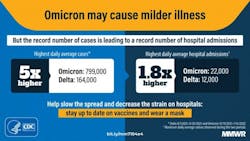Omicron variant disease severity lower but healthcare utilization high
The SARS-CoV-2 B.1.1.529 (Omicron) variant became predominant in the United States by late December 2021, leading to a surge in COVID-19 cases and associated ED visits and hospitalizations, according to a report from the Centers for Disease Control and Prevention (CDC).
Despite Omicron seeing the highest reported numbers of COVID-19 cases and hospitalizations during the pandemic, disease severity indicators, including length of stay, ICU admission, and death, were lower than during previous pandemic peaks.
Although disease severity appears lower with the Omicron variant, the high volume of hospitalizations can strain local healthcare systems and the average daily number of deaths remains substantial. This underscores the importance of national emergency preparedness, specifically, hospital surge capacity and the ability to adequately staff local healthcare systems. In addition, being up to date on vaccinations and following other recommended prevention strategies are critical to preventing infections, severe illness, or death from COVID-19.
The B.1.1.529 (Omicron) variant of SARS-CoV-2, the virus that causes COVID-19, was first clinically identified in the United States on December 1, 2021 and spread rapidly. By late December, it became the predominant strain, and by January 15, 2022, it represented 99.5% of sequenced specimens in the United States.
The Omicron variant has been shown to be more transmissible and less virulent than previously circulating variant. To better understand the severity of disease and healthcare utilization associated with the emergence of the Omicron variant in the United States, CDC examined data from three surveillance systems and a large healthcare database to assess multiple indicators across three high–COVID-19 transmission periods: December 1, 2020–February 28, 2021 (winter 2020–21); July 15–October 31, 2021 (SARS-CoV-2 B.1.617.2 [Delta] predominance); and December 19, 2021–January 15, 2022 (Omicron predominance). The highest daily 7-day moving average to date of cases (798,976 daily cases during January 9–15, 2022), emergency department (ED) visits (48,238), and admissions (21,586) were reported during the Omicron period, however, the highest daily 7-day moving average of deaths (1,854) was lower than during previous periods.
During the Omicron period, a maximum of 20.6% of staffed inpatient beds were in use for COVID-19 patients, 3.4 and 7.2 percentage points higher than during the winter 2020–21 and Delta periods, respectively. However, intensive care unit (ICU) bed use did not increase to the same degree: 30.4% of staffed ICU beds were in use for COVID-19 patients during the Omicron period, 0.5 percentage points lower than during the winter 2020–21 period and 1.2 percentage points higher than during the Delta period.
The ratio of peak ED visits to cases (event-to-case ratios) (87 per 1,000 cases), hospital admissions (27 per 1,000 cases), and deaths (nine per 1,000 cases [lagged by 3 weeks]) during the Omicron period were lower than those observed during the winter 2020–21 and Delta periods.
Further, among hospitalized COVID-19 patients from 199 U.S. hospitals, the mean length of stay and percentages who were admitted to an ICU, received invasive mechanical ventilation (IMV), and died while in the hospital were lower during the Omicron period than during previous periods. COVID-19 disease severity appears to be lower during the Omicron period than during previous periods of high transmission, likely related to higher vaccination coverage, which reduces disease severity, lower virulence of the Omicron variant and infection-acquired immunity.
Although disease severity appears lower with the Omicron variant, the high volume of ED visits and hospitalizations can strain local healthcare systems in the United States, and the average daily number of deaths remains substantial. This underscores the importance of national emergency preparedness, specifically, hospital surge capacity and the ability to adequately staff local healthcare systems. In addition, being up to date on vaccination and following other recommended prevention strategies are critical to preventing infections, severe illness, or death from COVID-19.
The daily 7-day moving average of COVID-19 cases, ED visits, and hospital admissions rapidly increased during the Omicron period. However, during the week ending January 15, 2022, ED visits appeared to be decreasing and the rapid increase in cases and hospital admissions appeared to be slowing. As of January 15, 2022, the maximum daily 7-day moving average number of cases (798,976), ED visits (48,238), admissions (21,586), and deaths (1,854) observed during the Omicron period reflects changes of 219%, 137%, 31%, and −46%, respectively, compared with those during the winter 2020–21 period, and 386%, 86%, 76%, and –4%, respectively, compared with those during the Delta period.
The largest relative differences in ED visits and admissions were observed among children and adolescents aged 0–17 years during the Omicron period; however, this age group represented only 14.5% of COVID-19 ED visits and 4.2% of COVID-19 admissions. During the Omicron period, a maximum of 20.6% of staffed inpatient beds were in use for COVID-19 patients, 3.4 and 7.2 percentage points higher than during the winter 2020–21 and Delta periods, respectively.
However, ICU bed use did not increase to the same degree: 30.4% of staffed ICU beds were in use for COVID-19 patients during the Omicron period, 0.5 percentage points lower than during the winter 2020–21 period and 1.2 percentage points higher than during the Delta period.
Emergence of the Omicron variant in December 2021 led to a substantial increase in COVID-19 cases in the United States. Although the rapid rise in cases has resulted in the highest number of COVID-19–associated ED visits and hospital admissions since the beginning of the pandemic, straining the healthcare system, disease severity appears to be lower than compared with previous high disease-transmission periods.
